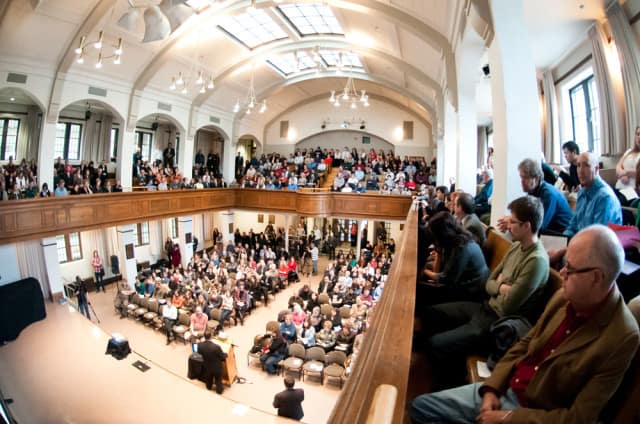
The University of Saskatchewan is being forced to take a hard look at its internal operations and trim any excess fat. The school faces a looming deficit after the provincial government scaled back its annual operating grant.
Hundreds of faculty, staff and students descended on Convocation Hall over the lunch hour Nov. 20 as the university held its third town hall this year to update campus on its ripening strategy to slash spending by 8.5 per cent over the next four years.
Based on current predictions, the university needs to cut $44.5 million in spending by 2016 to balance the books.
“For our university to be sustainable in both the short term and the long term, our expenses cannot keep rising faster than our revenues,” Provost and Vice-President Academic Brett Fairbairn said at the public meeting.
The widening budget gap comes in the wake of the provincial government’s decision in March to increase the university’s operating grant by just 2.1 per cent. The university had formally asked for a 5.8 per cent increase to cover the growing costs of salaries and building maintenance.
In the coming years the university expects the increase to the annual grant to be — at best — two per cent, which is the the primary driver behind the campuswide search for cost-saving measures. The university had planned to receive upwards of a five per cent increase each year until 2016.
The provincial grant provides the university with roughly 70 per cent of its operating revenue, with tuition and fees making up about 20 per cent. Specialized grants and investment account for the rest.
So far the university has cut $2.5 million in permanent expenses and $7 million in one-time savings to address the $15.5-million deficit projected this year.
The university recently announced the shuttering of the Emma Lake Kenderdine campus for the next three years, which will bank a total of $500,000. Dozens of supporters of the field campus from the fine arts and biology departments expressed anger and frustration over the closure at the town hall.
“Further one-time and permanent reductions are expected prior to the end of 2012-13, which will address the remaining outstanding deficit for [this year] of $6 million,” Greg Fowler, acting vice-president of resources and finance, said at the public meeting.
“The small amount of permanent savings to date appear minor compared to the challenge we face. But we are satisfied with this rate of progress because we are engaged in many activities in order to address this challenge. We have opted for a strategic approach rather than a quick and easy fix.”
Looking to sniff out efficiencies anywhere, the university has asked the campus community to submit suggestions as to where costs could be saved. More than 200 recommendations have rolled in since last spring.
The suggestions range from selling off used computers to reducing the number of campus art galleries to cutting sessional lecturers.
This year, 67 per cent of the university’s spending this year went to salaries and benefits for faculty and staff.
While 17 per cent of expenses went to library acquisitions, medical school accreditation, student financial aid and deferred building maintenance. The rest went to scholarships, utilities and basic office and furniture supplies for colleges.
Fairbairn said the required savings will not come from across-the-board department cuts, voluntary faculty and staff retirement packages or hiring freezes.
Ultimately, the decisions to cut programs and trim workforce costs will be made by the Provost’s Committee on Integrated Planning and the budget adjustment steering committee, which Fairbairn and Fowler co-chair.
“We’re aiming to review every aspect of the university’s operating budget and the associated activities,” Fairbairn said.
“The instruction from our board is to leave no stone unturned. So this is a comprehensive review of every aspect of the university’s finances.”
Deans, department heads and staff leaders have been asked to create workforce plans through to 2016 based on limited projected resources. These plans will guide targeted layoffs of faculty and staff.
“We know this project is causing a great deal of anxiety,” Fowler said. “It’s important to understand we’re in a very difficult financial situation that needs to be addressed. We have developed our services in a period where more resources were available.”
As of yet, there have not been any decisions made to layoff faculty or staff. But Fowler warned it will be inevitable over the coming four years.
NDP advanced education critic Cam Broten argues the university’s fiscal dire straits are a direct result of broken election promises made by the Saskatchewan Party.
He said on top of the shortfalls in the operating grant, the government forced the university to swallow an additional $100 million in debt after backing out of funding the remainder of the expansion of the Health Sciences building.
“The Sask. Party promised to fund our universities properly,” he said. “It’s an issue of living up to one’s commitments.”
But in Question Period Nov. 19, Sask. Party Minister of Advanced Education Don Morgan said the government has fulfilled its funding responsibilities.
“We expect that our post-secondary institutions will continually look for opportunities to improve effectiveness and efficiency in managing costs to make sure that financial stability continues in the future,” he said.
“We provided $304.5 million this budget year [to the U of S], which is a 46 per cent increase from 2007 when it was only $208.4 million.”
—
Photo: Raisa Pezderic/The Sheaf